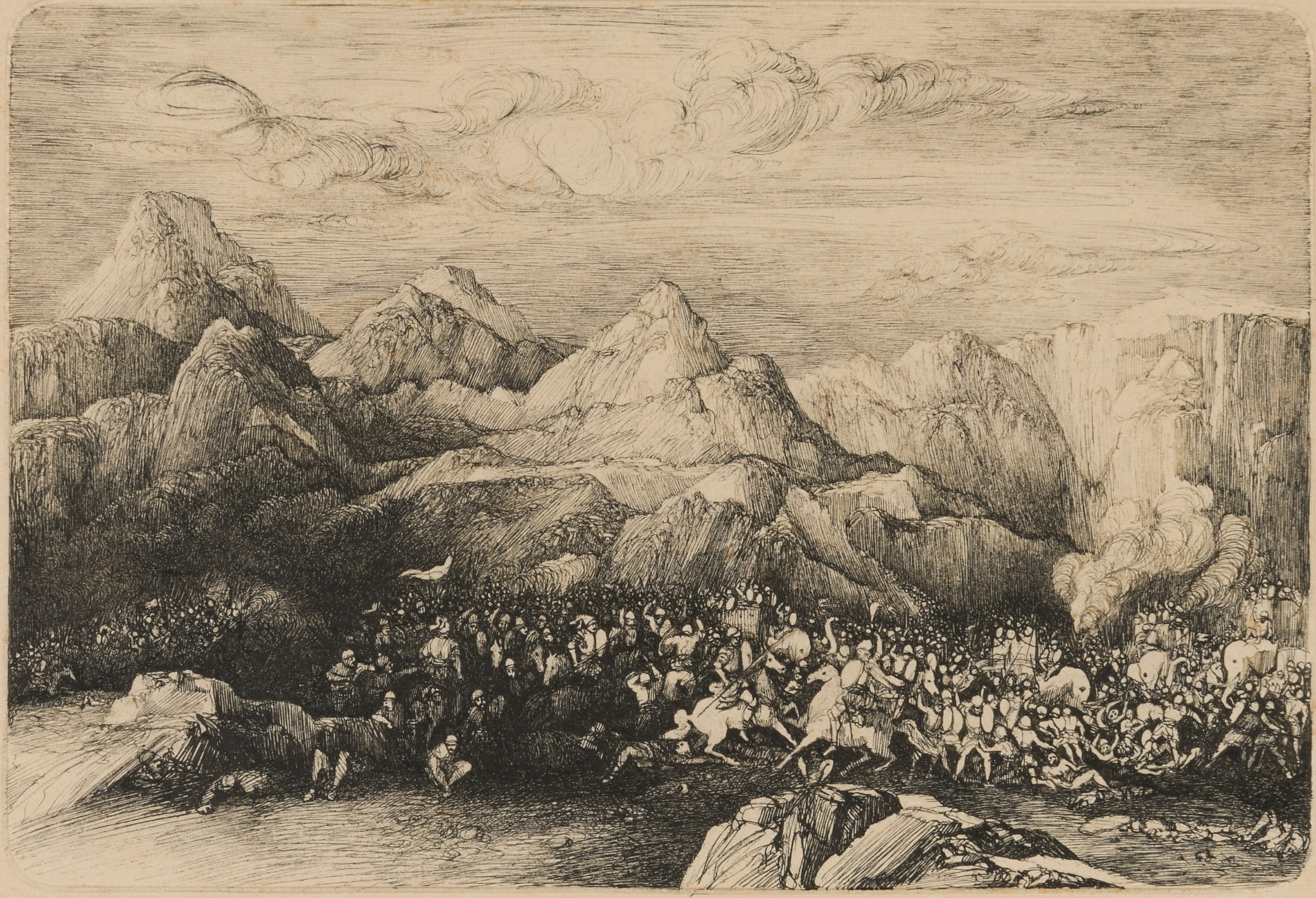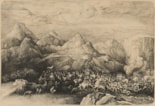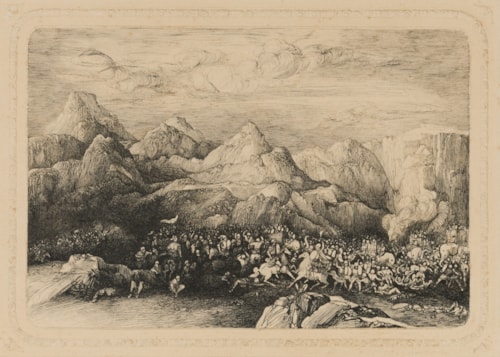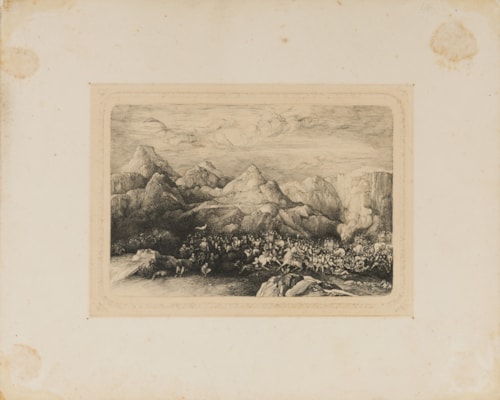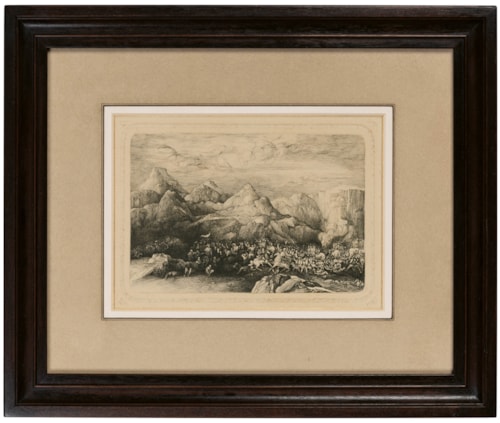Rodolphe BRESDIN
(Montrelais 1822 - Sèvres 1885)
A Battle in a Rocky Landscape (Hannibal’s Army Crossing the Alps?)
Pen and black ink on Bristol board with an embossed border.
Inscribed [word crossed out] inj / RS in brown ink and numbered 561 in red ink on the reverse of the board.
120 x 176 mm. (4 3/4 x 6 7/8 in.) [image]
145 x 200 mm. (5 3/4 x 7 7/8 in.) [with embossed border]
251 x 351 mm. (9 7/813 3/4 in.) [board]
Inscribed [word crossed out] inj / RS in brown ink and numbered 561 in red ink on the reverse of the board.
120 x 176 mm. (4 3/4 x 6 7/8 in.) [image]
145 x 200 mm. (5 3/4 x 7 7/8 in.) [with embossed border]
251 x 351 mm. (9 7/813 3/4 in.) [board]
As a draughtsman, Rodolphe Bresdin seems to have been fastidious in his choice of materials, preparing his tools - almost certainly using fine steel nibs - and mixing his inks with care, as well determining the surface on which he was to draw. The present sheet is drawn on an uncoated smooth paperboard known as Bristol board, which the artist often used for highly finished drawings made for exhibition or sale. As has been noted, ‘Bresdin used a smooth vellum, cream or ivory, for his finished ‘presentation’ drawings; and he often...used Bristols with decorative raised edges, perhaps originally made for mounting photographs or other souvenirs to be framed or placed in albums.’
The present sheet may be grouped with a number of elaborate drawings and etchings of battle scenes and vast armies on the march, often placed in barren surroundings or against a rocky mountain landscape, produced by Bresdin in the 1850s and 1860s. Drawings of similar subjects, usually on a small scale, are to be found today in the British Museum in London, the Bibliothèque Nationale in Paris, the Rhode Island School of Design Museum in Providence, the Metropolitan Museum of Art in New York and the Museum Boijmans van Beuningen in Rotterdam, as well as two sheets, one dated 1864 and the other 1865, that were in the Pierre Lafargue collection in Bordeaux in 1978.
As the print historian Maxime Préaud has pointed out, while he was undergoing treatment in a hospital in Paris in April 1870, Bresdin wrote a letter to a newspaper editor in Bordeaux describing his condition, albeit somewhat fatalistically, the tone of which finds some echoes in his drawings and prints of crowded battle scenes: ‘The battle has lasted 48 years. Unless there is a miracle, it is going to end and there is going to be peace. The enemy’s last battalions are preparing to charge; probes, scalpels and lancets are about to rush into my body, which is already so tired and weary. The last combatants gather for a final and decisive effort. As if that’s all it would take to bring me down.’
The present sheet is one of a handful of drawings and prints by Rodolphe Bresdin owned by the 20th century French engraver Emile Philippe Magadoux, known as Philippe Mohlitz (1941-2019), who created a number of fantastical prints and drawings.
The present sheet may be grouped with a number of elaborate drawings and etchings of battle scenes and vast armies on the march, often placed in barren surroundings or against a rocky mountain landscape, produced by Bresdin in the 1850s and 1860s. Drawings of similar subjects, usually on a small scale, are to be found today in the British Museum in London, the Bibliothèque Nationale in Paris, the Rhode Island School of Design Museum in Providence, the Metropolitan Museum of Art in New York and the Museum Boijmans van Beuningen in Rotterdam, as well as two sheets, one dated 1864 and the other 1865, that were in the Pierre Lafargue collection in Bordeaux in 1978.
As the print historian Maxime Préaud has pointed out, while he was undergoing treatment in a hospital in Paris in April 1870, Bresdin wrote a letter to a newspaper editor in Bordeaux describing his condition, albeit somewhat fatalistically, the tone of which finds some echoes in his drawings and prints of crowded battle scenes: ‘The battle has lasted 48 years. Unless there is a miracle, it is going to end and there is going to be peace. The enemy’s last battalions are preparing to charge; probes, scalpels and lancets are about to rush into my body, which is already so tired and weary. The last combatants gather for a final and decisive effort. As if that’s all it would take to bring me down.’
The present sheet is one of a handful of drawings and prints by Rodolphe Bresdin owned by the 20th century French engraver Emile Philippe Magadoux, known as Philippe Mohlitz (1941-2019), who created a number of fantastical prints and drawings.
A draughtsman and printmaker, Rodolphe Bresdin seems to have been entirely self-taught. His early career was spent in Paris, where he worked as an etcher. An eccentric, somewhat bohemian figure, he served as the inspiration for the impoverished artist-hero of Champfleury’s novel Chien-caillou, published in 1845; indeed, for most of his career Bresdin was also known by the nickname ‘Chien-Caillou’. He left Paris in 1849 for the town of Corrèze and by 1852 had settled in Toulouse, where he worked for several years. Despite living in abject poverty, this was a period of considerable productivity for the artist, who received several commissions and began to produce his first mature prints.
Although Bresdin exhibited in several Salons between 1848 and 1879, he failed to achieve much recognition or financial success. For most of the 1860’s he lived and worked in Bordeaux, where he briefly taught the young Odilon Redon, who was to become a devoted friend and champion. Bresdin emigrated to Canada in 1873 but struggled to make a living there and returned to France four years later, eventually working as a street-sweeper. In 1880, destitute and in ill-health, he abandoned his family and the following year moved into a garret in Sèvres, where he was found dead one day in January 1885. Although greatly admired by such writers as Champfleury, Baudelaire, Huysmans and Montesquieu, Bresdin’s work was first brought to public notice and acclaim at a retrospective exhibition held at the Salon d’Automne in 1908.
As no paintings by the artist have survived, Bresdin’s entire oeuvre consists of drawings, etchings and lithographs. While his graphic work is well-known today, Bresdin’s activity as a draughtsman is equally vital to an understanding of his art. Like his prints, his drawings were never on a very large scale, yet were always intricately drawn and minutely detailed.
Many of Bresdin’s drawings are finished works in pen and ink, and were created as independent works of art for exhibition or sale. However, from a career spanning some fifty years, only slightly more than four hundred drawings by Bresdin survive today, alongside a graphic oeuvre of around 160 prints. Only rarely do his drawings appear on the market, and they remain particularly scarce outside important groups of sheets in several public collections, notably the Bibliothèque Nationale in Paris, the Gemeentemuseum in The Hague and the Art Institute of Chicago; each based on collections formed by particular friends of the artist, to whom he presented his drawings.
Provenance
Emile Philippe Magadoux, called Philippe Mohlitz, Bordeaux
His posthumous sale, Bordeaux, Blanchy-Lacombe, 12 October 2019, lot 416
Talabardon & Gautier, Paris.
His posthumous sale, Bordeaux, Blanchy-Lacombe, 12 October 2019, lot 416
Talabardon & Gautier, Paris.

